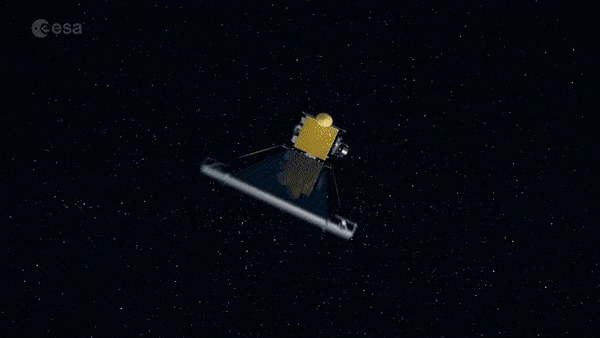
Copernical Team
Sino-Russian center for space weather monitoring operational
 A space weather center set up by China and Russia began operating on Tuesday to provide services for aviation operators around the world.
The China-Russia Consortium Global Space Weather Center monitors space weather events including solar activities and releases advisories for aviation operators, said Zhang Xiaoxin, director of the National Satellite Meteorological Center's space weather
A space weather center set up by China and Russia began operating on Tuesday to provide services for aviation operators around the world.
The China-Russia Consortium Global Space Weather Center monitors space weather events including solar activities and releases advisories for aviation operators, said Zhang Xiaoxin, director of the National Satellite Meteorological Center's space weather Russian Military Publishes First Video From Successful Anti-Satellite Missile Test
 Earlier in the day, the Defence Ministry confirmed that Russia had successfully conducted an anti-satellite test on Monday, hitting a long-defunct Soviet satellite floating lifelessly in orbit. The military dismissed claims made by US officials that the test creates thousands of pieces of debris "threatening the interests of all nations."
The Russian Ministry of Defence published a video T
Earlier in the day, the Defence Ministry confirmed that Russia had successfully conducted an anti-satellite test on Monday, hitting a long-defunct Soviet satellite floating lifelessly in orbit. The military dismissed claims made by US officials that the test creates thousands of pieces of debris "threatening the interests of all nations."
The Russian Ministry of Defence published a video T Russian MoD: US Perfectly Aware Fragments of Downed Satellite Pose No Threat to Space Activities
 On Monday, State Department spokesman Ned Price accused Russia of "recklessly" carrying out a destructive satellite test using an anti-satellite missile against a defunct Soviet satellite. Washington claims the test generated "over 1,500 pieces of trackable orbital debris" which now "threaten the interests of all nations."
The Russian military confirmed Tuesday that it has carried out a su
On Monday, State Department spokesman Ned Price accused Russia of "recklessly" carrying out a destructive satellite test using an anti-satellite missile against a defunct Soviet satellite. Washington claims the test generated "over 1,500 pieces of trackable orbital debris" which now "threaten the interests of all nations."
The Russian military confirmed Tuesday that it has carried out a su Russia ready to discuss all space security issues with US
 Russia is ready to discuss the entire spectrum of space security issues with all interested countries, including the United States, Russian Foreign Ministry spokeswoman Maria Zakharova said.
"We confirm our readiness to discuss the entire spectrum of space security issues with all interested states, including the United States. We are convinced that the launch of negotiations on an interna
Russia is ready to discuss the entire spectrum of space security issues with all interested countries, including the United States, Russian Foreign Ministry spokeswoman Maria Zakharova said.
"We confirm our readiness to discuss the entire spectrum of space security issues with all interested states, including the United States. We are convinced that the launch of negotiations on an interna Musk says first orbital flight for Moon rocket in early 2022
 Elon Musk said Wednesday that the Starship developed by his company SpaceX and selected by NASA for the Americans' return to the Moon would attempt its first orbital flight early next year.
"We'll do a bunch of tests in December and hopefully launch in January," Musk said in a talk for the National Academies Space Studies Board.
"There's a lot of risk associated with this first launch,"
Elon Musk said Wednesday that the Starship developed by his company SpaceX and selected by NASA for the Americans' return to the Moon would attempt its first orbital flight early next year.
"We'll do a bunch of tests in December and hopefully launch in January," Musk said in a talk for the National Academies Space Studies Board.
"There's a lot of risk associated with this first launch," Planetary defenders: after NASA’s DART comes ESA’s Hera

The world will be watching the milestone launch of NASA’s Double Asteroid Redirection Test, DART, spacecraft on Wednesday, 24 November, intended to alter one small part of the Solar System forever.
Alien organisms: Hitchhikers of the galaxy?

Scientists warn that without good biosecurity measures, 'alien organisms' on Earth may become a reality stranger than fiction.
Published in international journal BioScience, a team of scientists, including Dr. Phill Cassey, Head of the Department of Ecology and Evolutionary Biology at the University of Adelaide, are calling for greater recognition of the biosecurity risks ahead of the space industry.
"In addition to government-led space missions, the arrival of private companies such as SpaceX has meant there are now more players in space exploration than ever before," said Associate Professor Cassey. "We need to take action now to mitigate those risks."
Space biosecurity concerns itself with both the transfer of organisms from Earth to space (forward contamination) and vice-versa (backward contamination). While the research points out that at present the risk of alien organisms surviving the journey is low, it's not impossible.
Dr. Cassey said: "Risks that have low probability of occurrence, but have the potential for extreme consequences, are at the heart of biosecurity management. Because when things go wrong, they go really wrong."
The research provides clear evidence of how humans have spread organisms to the remotest regions of the earth and sea, and even into space.
NASA extends Hubble operations contract, provides mission update

The Hubble Space Telescope, a project of international cooperation between NASA and ESA (European Space Agency), has fundamentally changed the way we view our universe time and again. Now in its 32nd year in space, Hubble has delivered unprecedented insights about the cosmos, from the most distant galaxy observed so far to familiar planets in our neighborhood, including Jupiter, Saturn, Uranus, and Neptune.
"Hubble, with its beautiful images and decades-long series of new discoveries about our universe, has captured the imagination of countless individuals and inspired so many," said Dr. Thomas Zurbuchen, associate administrator for NASA's Science Mission Directorate at the agency's Headquarters in Washington.
With Hubble continuing to make groundbreaking discoveries, the agency has awarded a sole source contract extension to the Association of Universities for Research in Astronomy (AURA) in Washington for continued Hubble science operations support at the Space Telescope Science Institute (STScI) in Baltimore, which AURA operates for NASA. The award extends Hubble's science mission through June 30, 2026, and increases the value of the existing contract by about $215 million (for a total of about $2.4 billion).
The Incredible Adventures of the Hera mission – Episode 2
 Video:
00:03:27
Video:
00:03:27
Meet Hera, our very own asteroid detective. Together with two CubeSats – Milani the rock decoder and Juventas the radar visionary – Hera is off on an adventure to explore Didymos, a double asteroid system that is typical of the thousands that pose an impact risk to planet Earth.
Suitable for kids and adults alike, this episode tells the story of the discovery of asteroids, in ‘The Curious Case of the Missing Planet’. Astronomers in the 18th century were sure there was a planet in the wide gap between Mars and Jupiter – and even formed a group
Satellite attack: the mounting arms race in space
 Last year a US general made an ominous revelation: two Russian satellites in orbit were stalking a US spy satellite high above the earth.
It wasn't clear if the Cosmos satellites could attack USA-245, an American surveillance spacecraft.
"It has the potential to create a dangerous situation in space," said General Jay Raymond, head of the Pentagon's Space Command.
The incident passed
Last year a US general made an ominous revelation: two Russian satellites in orbit were stalking a US spy satellite high above the earth.
It wasn't clear if the Cosmos satellites could attack USA-245, an American surveillance spacecraft.
"It has the potential to create a dangerous situation in space," said General Jay Raymond, head of the Pentagon's Space Command.
The incident passed 